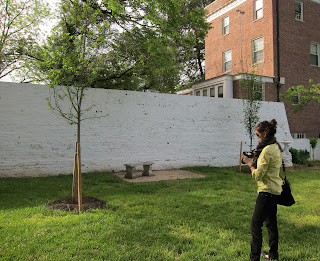15 JULY 2011
WASHINGTON’S HOT SUMMERS hit sidewalk trees with a double whammy. Heat from the sun above bakes the leaves and dries the soil. The sun’s heat also bounces up from the pavement baking the leaves from below. So trees are cooked from above, cooked from below, while their growing medium dries out. Ouch!
So regular watering of young and vulnerable trees is crucial, especially trees in paved areas.
Each summer, Restore Mass Ave urges property owners to turn their hoses onto the sidewalk trees: 25 gallons each week, dripped slowly. Or to refill the bags we zip around the trees, which allow a slow drip from holes in the bottom. In the terrible drought of 2007, we paid for a truck to water about 120 city trees. (Thanks to your donations!) We can’t be sure but believe that many of these trees would have died without this help.
Our Treekeeper volunteers work on hard-to-reach “orphan” trees, by dragging hoses hooked to nearby spigots. Sometimes they carry water-filled buckets in our red Flyer wagon to and from a parched tree.
Below see RMA Treeekeeper Sarah Randolph at work. (Photo: Restore Mass Ave)
This summer, fire hydrants will be our new rescue tool. We’re being loaned a Fire Hydrant Meter by the Dupont Circle Citizens’ Association on days DCCA doesn’t need it. The device (see photo) is a water meter and pressure converter; there is also a key for unlocking the hydrant.
The Fire Hydrant Meter measures the quantity of water used. It converts the high-pressure water from the hydrant to a low enough pressure for a garden hose – just right for helping a tree. (Trees should be given water slowly, so the soil and roots can to absorb it.)
The equipment is heavy, so we tow it in our red Flyer wagon along the sidewalk from hydrant to hydrant. (DCCA tows it on a bike trailer.)
Thus our water-brigade can water the sidewalk trees which need water, with the amount they need, when they need it.
Note: RMA will provide this care on just few afternoons; the hydrant-watering is NO substitute for the main weekly water trees building owners should provide to nearby sidewalk trees.
See below for useful links for fire hydrant watering.
Recordall® Fire Hydrant Meter (Photo: Badger Meter)
--
Useful links
Note: To use a public hydrant for tree-watering, you must obtain a Fire Hydrant Use Permit from DC Water (WASA), a hydrant key and pay a deposit. The Meter measures water used, which you must pay for. See
Casey Trees' summer crew also waters by-cycle. See
http://www.caseytrees.org/planting/water-by-cycle/index.php
http://www.dcwater.com/business/permits/fire_hydrant_use.cfm
http://www.dcwater.com/business/permits/fire_hydrant_use.cfm
--
Credits:
We thank Doug Rogers, chair of the DCCA Tree Committee, and Greg Zahn of DCCA for sharing the equipment and how to use it.
Thanks also go to Washington Area Bicyclist Association (WABA) for the training class in using hydrants for tree-watering. Casey Trees inspired us all with their Water By-Cycle Cart it uses to be sure the trees it plants on city streets get enough water.










